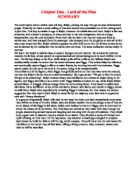The text concerns Ralph, Jack and Simon tackling the job of exploration with boyish enthusiasm, eventually discovering that they really are on a picturesque, tropical island, complete with lagoon, reefs, mountain and jungle. On their return, they find a piglet caught in the creepers, and although Jacks draws his knife to kill it, he cannot persuade himself to do so.
Even at the onset, Jack appears to be an ominous figure; the lead singer in the school choir, he holds a certain power over the other choirboys as they walk towards the beach to follow the first sound of the conch. He does allow them to rest despite the heat and fatigue of wearing full black uniform gowns and caps while they walk in two parallel lines toward the conch. Only when Simon faints does he show sympathy. Described as 'tall, thin, and bony...his hair was red beneath the black cap. His face was...freckled, and ugly without silliness' (Chapter 1 pg. 19). It is Jack who leads the boys' turn to savagery, or at least gives it a certain order. He is Ralph's chief nemesis; it is he who has brought with him a knife and who gradually becomes obsessed with hunting and killing the pigs on the island. His main contribution to the survival of the boys is to track the pigs and provide meat. Meat is not absolutely essential to their survival (the island is blessed with fruits, crabs and shellfish) yet he insists on its importance. In this sense he represents Man the Hunter, althought he sees the entire experience on the island as a game, he exhibits a basic, primeval instinct – the urge to hunt. The end of chapter 1 offers a great sense of foreboding; on this occasion Jack remains binded to his moral values, “and broughht his arm down replacing the blade in the sheath,” but on the next occasion, there will be no mercy. While Jack's first attempt to kill the pig failed, his quote "next time..." foreshadowed his future of savage hunting. At this stage, Jack still recognises the taboo – his culture will not allow such brutality as stabbing. The other consequence of Jack’s hunting instinct is bizarre and sinisteer. He goes from hunting animals to hunting people. Survival then becomes not a matter of finding food but manifests itself into warfare.
Jack’s physical appearance throughout the novel is also a deliberate and blatant warning sign. His red hair stands out, as well as being associated with a fiery temper it also, significantly, indicated danger. When he, quite literally, masks his appearance with paint, far from neutralising his venom and pugnacity it gives it free rein. Hidden behind it he can absolve himself of decency and responsibility, realising his most extreme evil potential.
Golding is very cunning when dealing with contrasts, he creates this beautiful environment, which is being inhabited by these twisted individuals, “He looked round fiercely, daring them to contradict. Then they broke out into the sunlight…” This dark and sinister contrast with normality, and emphasises how these children are spiralling out of control.
Because the novel is an allegory, each character signifies an important idea or theme. Ralph represents order, leadership, and civilization; Piggy represents the scientific and intellectual aspects of civilization; Jack represents savagery and the desire for power; Simon represents natural human goodness; and Roger represents brutality and bloodlust at their most extreme. Each character represents a level, a respone, an agenda. Chapter 1 meanwhile is the whole novel in embryo form, symbolic of furture events.







